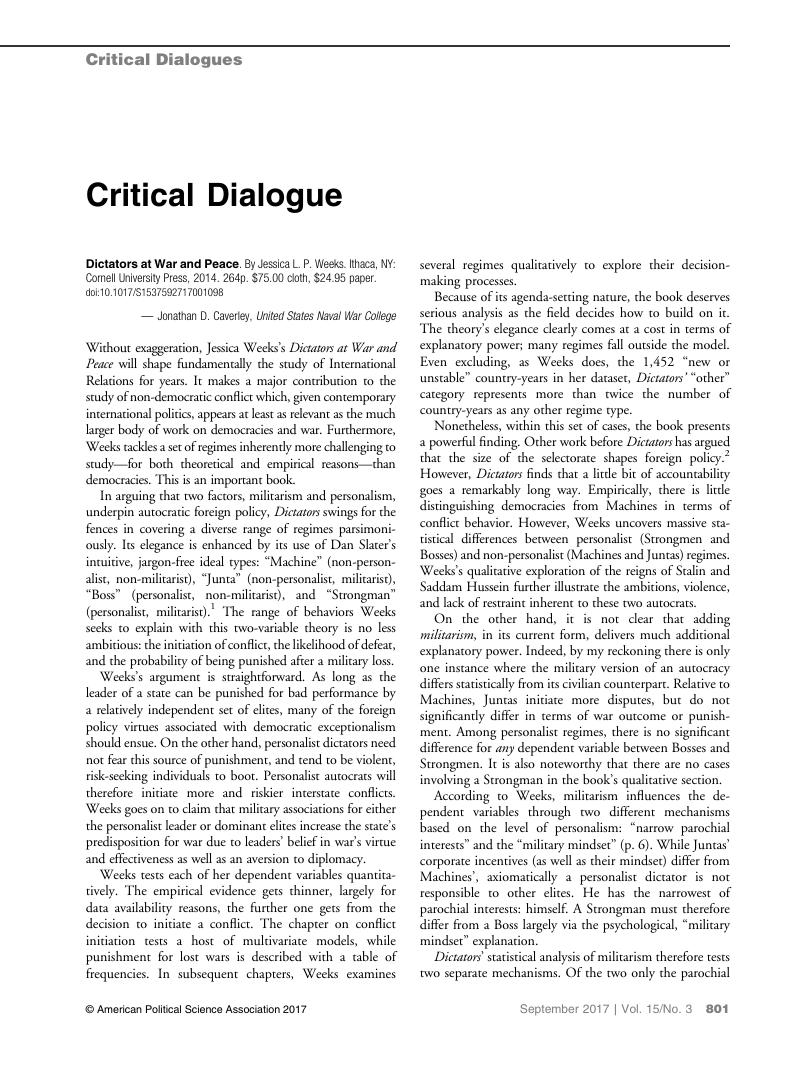No CrossRef data available.
Article contents
Dictators at War and Peace. By Jessica L. P. Weeks. Ithaca, NY: Cornell University Press, 2014. 264p. $75.00 cloth, $24.95 paper.
Published online by Cambridge University Press: 18 August 2017
Abstract
An abstract is not available for this content so a preview has been provided. Please use the Get access link above for information on how to access this content.

- Type
- Critical Dialogues
- Information
- Copyright
- Copyright © American Political Science Association 2017
References
Avant, Deborah and Lebovic, James. 2000. “U.S. Military Attitudes toward Post-Cold War Missions.”
Armed Forces & Society
27: 37–56. doi:10.1177/0095327X0002700104.Google Scholar
Betts, Richard K. 1991. Soldiers, Statesmen, and Cold War Crises. Cambridge, MA: Harvard University Press.Google Scholar
Bueno de Mesquita, Bruce, Smith, Alastair, Siverson, Randolph M., and Morrow, James D.. 2003. The Logic of Political Survival. Cambridge, MA: MIT Press.CrossRefGoogle Scholar
Carter, Jeff. 2015. “The Political Cost of War: Mobilization in Democracies and Dictatorships.”
Journal of Conflict Resolution. doi:10.1177/0022002715620469.Google Scholar
Desch, Michael C. 1999. Soldiers, States, and Structure: Civilian Control of the Military in a Changing Security Environment. Baltimore, MD: Johns Hopkins University Press.Google Scholar
Feaver, Peter D. and Gelpi, Christopher F.. 2004. Choosing Your Battles: American Civil-Military Relations and the Use of Force. Princeton, NJ: Princeton University Press.Google Scholar
Horowitz, Michael C. and Stam, Allan C.. 2014. “How Prior Military Experience Influences the Future Militarized Behavior of Leaders.”
International Organization
68(3): 527–59. doi:10.1017/S0020818314000046.Google Scholar
Huntington, Samuel P. 1959. The Soldier and the State: The Theory and Politics of Civil-Military Relations. Cambridge, MA: Belknap.Google Scholar
Lai, Brian and Slater, Dan. 2006. “Institutions of the Offensive: Domestic Sources of Dispute Initiation in Authoritarian Regimes 1950–1992.”
American Journal of Political Science
50(1): 113–26.Google Scholar
Narizny, Kevin. 2001. The Political Economy of Grand Strategy. Princeton, NJ: Princeton University Press.Google Scholar
Sechser, Todd S. 2004. “Are Soldiers Less War-Prone than Statesmen?”
Journal of Conflict Resolution
48(5): 746–74. doi:10.1177/0022002704268025.Google Scholar
Slater, Dan. 2003. “Iron Cage in an Iron Fist: Authoritarian Institutions and the Personalization of Power in Malaysia.”
Comparative Politics
36(1): 81–101.Google Scholar
Stewart, Brandon M. and Zhukov, Yuri M.. 2009. “Use of Force and Civil–Military Relations in Russia: An Automated Content Analysis.”
Small Wars & Insurgencies
20(2): 319–43. doi:10.1080/09592310902975455.Google Scholar
Vagts, Alfred. 1959. A History of Militarism: Civilian and Military. New York: Meridian Books.Google Scholar




